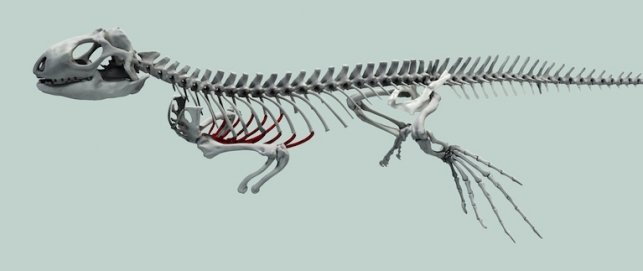Zentralinstitut der Humboldt-Universität zu Berlin

Morphology and History of Forms
Research topic
The working group undertakes both biological basic research on form-function relationships and the evolution of vertebrates, and in parallel reflects upon this research process focusing on the images used in it.
Functional morphological research is dependent on images: structural descriptions are produced based on drawings and/or 3D reconstructions using imaging processes; experimental results are visualised using data graphics; models, schemas, animations, etc., are used in order to generate new knowledge and to communicate it to colleagues or the public. The working group integrates collections-based issues and experimental approaches. We are therefore able to analyse this programme of research with regard to the images used in organismic biology.
Objective
In addition to functional morphological research, the interdisciplinary composition of the working group enables direct observation of the research process with a focus on the use of images.
The working group’s work on the form-function relationship aims to further the understanding of evolutionary adaptations in vertebrates. Adaptation is a fundamental concept in evolutionary biology; however, its characterisation must take diverse forces into account. This calls for an integrative research approach.
The objective of the image-studies analyses conducted in parallel to these investigations is to uncover image-mediated evidence generation. »Finished« images are the result of a production process – in some cases a complex one – which is influenced by very different interests held by, and decisions taken by, the image makers concerned (e.g. representational conventions, the desire to emphasise especially important results, different objectives for their use and the technical conditions of image production). It is often not possible to reconstruct transformation stages and »deletions« by examining the finished image. The working group documents and scrutinises every stage in the genesis of images.
Execution
Functional morphology of vertebrates:
1. Morphologically disparate species from a close group of related species will be identified with the help of statistical form analysis (geometrical morphometrics). This analysis will be based on surface models produced in collections (such as the Museum für Naturkunde, Berlin) using a transportable laser scanner (Skiron, Microscribe). We will investigate whether form differences correlate with different forms of life and movement (e.g. burrowing, climbing, jumping, etc.).
2. An in-depth structural analysis will be conducted on the identified species: skeleton anatomy and proportions, bone microstructure, muscle topography, 3D fascicle reconstruction. Hypotheses on the form-function relationship will be formulated based on the observed structural differences.
3. We will test the anatomically derived hypotheses in in vivo experiments. Motion studies will also be conducted using high-speed videography and evaluated in three dimensions. Ground reaction force measurements can be gathered simultaneously and used in biomechanical descriptions (leading up to inverse dynamics).
Image-studies analysis of the images used in functional morphology:
1. To enable the reconstruction of the historical logic of images used in the study of vertebrate morphology, firstly all relevant images from two publications with long histories (the Journal of Morphology, Proceedings of the Royal Society) will be collected and then compared in a timeline. We will then examine the timeline in the light of the history of ideas in evolutionary biology and identify conventions and their violations as well as variable and invariable image components.
2. Our enquiry will consider the role of visual representations in current research work, from the conception phase right through to the submission of a thesis. The image-studies investigation is interested in keywords such as abstraction, schematisation, transformation and deletion.
3. Collaboration between natural scientists and professional illustrators has a long history. We will ask under which conditions and for what purposes such collaborations are still possible today or may be possible again.
Securing the results
The working group’s activities will be accompanied by (interdisciplinary) academic publications. We will also produce an interdisciplinary exhibition with the assistance of students. The exhibition will appear at the Animal Anatomy Theatre in the Helmholtz Centre for Cultural Techniques, amongst other venues, and will highlight the tense relationship between »science« and »fiction« in fossil reconstruction from both a biological/palaeontological perspective and an image-studies perspective.
